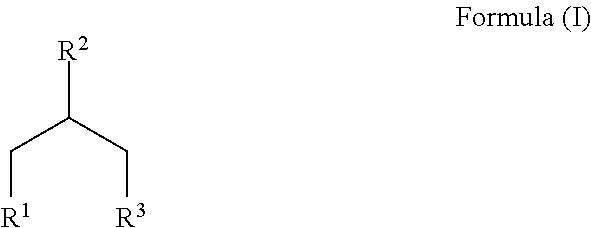New polyglycerol esters and their use
a polyglycerol ester and polyglycerol ester technology, applied in the field of polyglycerol esters, can solve the problems of excessive cost of currently used actives, inability to use varied effects of existing fabric softening compositions, etc., to achieve excellent emulsification properties, enhance deposition, and increase the viscosity effect of formulations
- Summary
- Abstract
- Description
- Claims
- Application Information
AI Technical Summary
Benefits of technology
Problems solved by technology
Method used
Image
Examples
example 1
Preparation of [PGE 37]
[0112]500 g glycerol and 2.5 g of potassium hydroxide were heated to 240° C. at a pressure of 400 mbar while nitrogen was bubbled through the mixture. Reaction water was continuously distilled from the reaction mixture. When the refractive index reached 1.4920, the reaction mixture was cooled and subjected to thin film distillation at a temperature of 250° C. and a pressure of 4 mbar.
[0113]The distillation residue had a hydroxyl value of 1150 mg KOH / g, a polydispersity index of 0.71 and contained 1.5% of cyclic polyglycerols
[0114]215.1 g of this product were reacted with 494.3 g of partially hydrogenated tallow fatty acid (C16 / 18) with an iodine value of 20 at a temperature of 240° C. while sparging with nitrogen. Reaction water was continuously distilled from the mixture. When the acid value reached <10 mg KOH / g, 90.6 g sebacic acid were added to the reaction mixture and the reaction was continued to an acid value of <3 mg KOH / g. Subsequently, the reaction wa...
example 2
Preparation of [PGE 38]
[0115]500 g glycerol and 2.5 g of potassium hydroxide were heated to 240° C. at a pressure of 400 mbar while nitrogen was bubbled through the mixture. Reaction water was continuously distilled from the reaction mixture. When the refractive index reached 1.4920, the reaction mixture was cooled and subjected to thin film distillation at a temperature of 250° C. and a pressure of 4 mbar.
[0116]The distillation residue had a hydroxyl value of 1150 mg KOH / g, a polydispersity index of 0.71 and contained 1.5% of cyclic polyglycerols 208 g of this product were reacted with 478.1 g of partially hydrogenated tallow fatty acid (C16 / 18) with an iodine value of 20 at a temperature of 240° C. while sparging with nitrogen. Reaction water was continuously distilled from the mixture. When the acid value reached <10 mg KOH / g, 113.9 g sebacic acid were added to the reaction mixture and the reaction was continued to an acid value below 3 mg KOH / g. Subsequently, the reaction was st...
example 3
Preparation of [PGE 39]
[0117]500 g glycerol and 2.5 g of potassium hydroxide were heated to 240° C. at a pressure of 400 mbar while nitrogen was bubbled through the mixture. Reaction water was continuously distilled from the reaction mixture. When the refractive index reached 1.4920, the reaction mixture was cooled and subjected to thin film distillation at a temperature of 250° C. and a pressure of 4 mbar.
[0118]The distillation residue had a hydroxyl value of 1150 mg KOH / g, a polydispersity index of 0.71 and contained 1.5% of cyclic polyglycerols.
[0119]204.3 g of this product were reacted with 352.1 g of partially hydrogenated tallow fatty acid (C16 / 18) with an iodine value of 20 at a temperature of 240° C. while sparging with nitrogen. Reaction water was continuously distilled from the mixture. When the acid value reached <10 mg KOH / g, 243.6 g Dimer acid (Radiacid 0977, Oleon) were added to the reaction mixture and the reaction was continued to an acid value of <3 mg KOH / g. Subseq...
PUM
| Property | Measurement | Unit |
|---|---|---|
| degree of polymerization | aaaaa | aaaaa |
| molar ratio | aaaaa | aaaaa |
| molar ratio | aaaaa | aaaaa |
Abstract
Description
Claims
Application Information
 Login to View More
Login to View More - R&D
- Intellectual Property
- Life Sciences
- Materials
- Tech Scout
- Unparalleled Data Quality
- Higher Quality Content
- 60% Fewer Hallucinations
Browse by: Latest US Patents, China's latest patents, Technical Efficacy Thesaurus, Application Domain, Technology Topic, Popular Technical Reports.
© 2025 PatSnap. All rights reserved.Legal|Privacy policy|Modern Slavery Act Transparency Statement|Sitemap|About US| Contact US: help@patsnap.com



